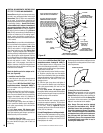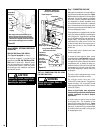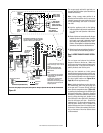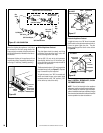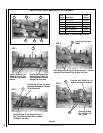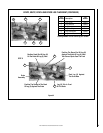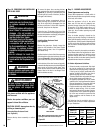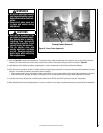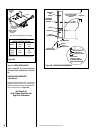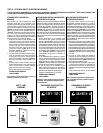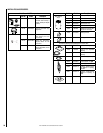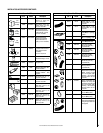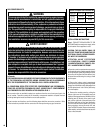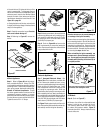
34
NOTE: DIAGRAMS & ILLUSTRATIONS ARE NOT TO SCALE.
Step 10. REMOVING AND INSTALLING
THE GLASS DOOR
Air Shutter Adjustment Guidelines:
Amount of
Primary Air
Flame
Color
Air Shutter
Adjustment
If air shutter is
closed too far
Flame will
be orange
Air shutter
gap should be
increased
If air shutter is
open too far
Flame will
be blue
Air shutter
gap should be
decreased
Air Shutter Adjustment Guidelines
• If there is smoke or soot present, rst check
the log set positioning to ensure that the
flames are not impinging on any of the logs.
If the log set is properly positioned and a
sooting condition still exists, then the air
shutter opening should be increased.
• The more offsets in the vent system, the larger
the air shutter opening will need to be.
• An appliance operated with the air shutter
opened too far, may have flames that appear
blue and transparent. These weak, blue and
transparent flames are termed anemic.
• Propane models may exhibit ames which
candle or appear stringy. If this is present
and persists, adjust the air shutter to a more
closed position, then operate the appliance
for a few more minutes to ensure that the
flame normalizes and the flames do not
appear sooty.
The following chart is provided to aid you in
achieving the correct air shutter adjustment
for your installation.
Step 11. BURNER ADJUSTMENTS
Flame Appearance and sooting
Proper flame appearance is a flame which is
blue at the base and becomes yellowish-orange
in the body of the flame.
Figure 63
To access the glass door securing latches,
first open the lower control compartment door
(Figure 63 ) by pushing in simultaneously the
left and right top corners of the door (the door
is hinged at the bottom).
Remove the bottom compartment door by
sliding the hinge pin, located at the door’s left
side, to the right until it disengages from the
left corner post hole. Pull the door diagonally
to the left, away from the fireplace.
Locate the two (2) latches at the top of the
control compartment and disengage them from
the door frame bottom vee-flange, pulling down
on their handles to open them.
Installing Glass Enclosure Panel
(see Figure 63 )
Retrieve the glass door. Visually inspect the
gasket on the backside of the frame. Gasket
surface must be clean, free of irregularities
and seated firmly.
Position the door in front of the firebox opening
with the bottom of the door held away from the
fireplace (Figure 63 ). Hook the top flange of the
door frame over the top of the firebox frame.
Let the bottom of the door frame swing gently
in towards the fireplace ensuring that the gasket
seats evenly as the door frame draws shut.
Fasten the two latches located underneath the
firebox floor to the door's vee-flange. Close
both the latches securely.
Glass Door
Latch
Control Compartment Access Panel and Hinge
Front Glass
Enclosure Panel
Firebox Floor
Bottom Vee-flange
Glass Door Frame
Top Flange
Glass Door Frame
Modesty Panel
EDVST SHOWN
Note: When installing the glass door, ensure the
spacing on both sides is even and equal.
Only doors certified with the appliance
shall be used.
Seules des portes certifiées pour cet
appareil doivent être utilisées.
CAUTION: DO NOT abuse glass door by
striking or slamming shut.
Removing Glass Enclosure Panel
(see Figure 63 )
Remove the top louver assembly or radiant
panel.
WARNING
• Do not attempt to substitute the
materials used on these doors,
or replace cracked or broken
glass.
• Handle this glass with extreme
care! Glass is susceptible to
damage – Do not scratch or
handle roughly while reinstall-
ing the glass door frame.
• The glass door(s) of this appli-
ance must only be replaced as
a complete unit as provided
by the manufacturer. Do not
attempt to replace broken,
cracked or chipped glass sepa-
rately.
• Do not attempt to touch the
front enclosure glass with your
hands while the fireplace is in
use.
WARNING
Do not operate appliance with
the glass front removed, cracked
or broken.
AVERTISSEMENT
Ne pas utiliser l'appareil si le
panneau frontal en verre n'est
pas en place, est craqué ou
brisé.
When the appliance is first lit, the entire
flame may be blue and will gradually turn
yellowish-orange during the first 15 minutes
of operation. If the flame remains blue, or if
the flame is orange with evidence of sooting
(black tip), the air shutter opening may need
to be adjusted.
If the air shutter opening is closed too far,
sooting may develop. Sooting is indicated by
black puffs developing at the tips of very long
orange flames. Sooting results in black deposits
forming on the logs, appliance inside surfaces
and on exterior surfaces adjacent to the vent
termination.
Sooting is caused by incomplete combustion
in the flames and lack of combustion air enter-
ing the air shutter opening. To achieve a warm
yellowish-orange flame with an orange body
that does not soot, the shutter opening must be
adjusted between these two extremes.



